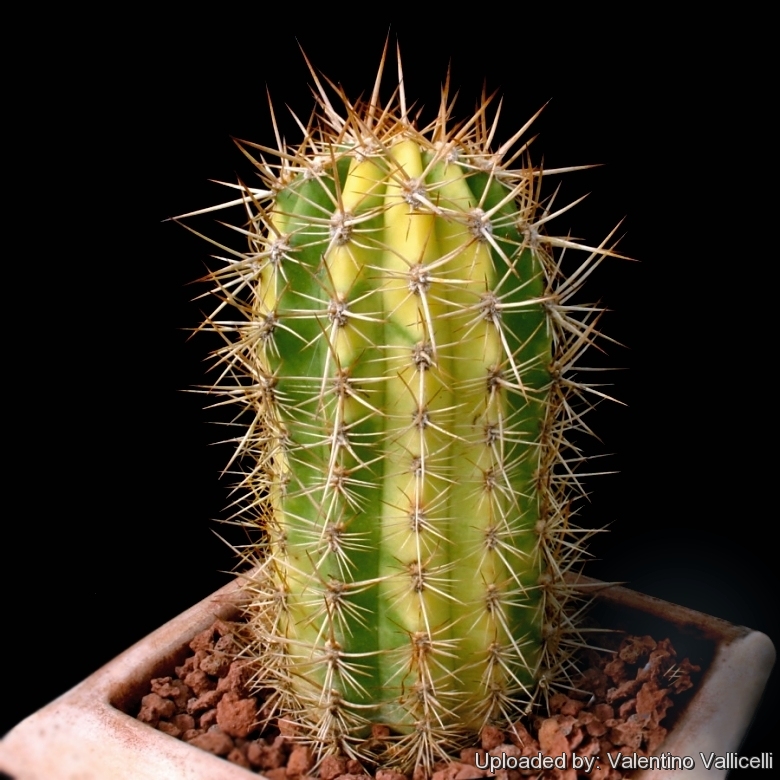
Echinopsis spachiana f. variegata Photo by: Valentino Vallicelli
Origin and Habitat: Garden origin (Nursery produced cultivar)
Synonyms:
See all synonyms of Echinopsis spachiana
Description: The classical Echinopsis spachianaSN|8648]]SN|8648]] (a.k.a. Golden Torch Cactus) is a multi-stemmed columnar cactus at first simple, later profusely branching at the base. The rare variegated form has sectors, patches or stripes with distinct shades of yellow. A very few variegated plants sprout unpredictably time by time among normal green seedling and are very rare. Plants with variegated stems are often attractive and highly prized.
Stem: Stem upright up to about 2 m tall, but usually smaller, 5 to 6 cm in diameter, columnar. Epidermis green and yellow.
Ribs: 10 to 15, obtuse, rounded.
Areoles: About 1 cm apart, large, covered with curly yellow wool, turning white or grey as they age.
Spines: Radial spines 8 to 10, 6 mm to 1 cm long, spreading, stiff, sharp, amber-yellow to brown.
Central spines: 1 to 3 yellowish, 12 mm long, stronger and longer than the radials; all the spines later becoming grey.
Flower: Nocturnal, white, about 20 cm long and 15 cm in diameter lasting about 24 hours from one sunset to the following one.
Blooming time: Late spring.
Subspecies, varieties, forms and cultivars of plants belonging to the Echinopsis spachiana group
Cultivation and Propagation: Variegated cacti are regarded as choice and difficult in cultivation, but despite that many of them are relatively easy to grow. But be aware that they cannot tolerate prolonged exposure to direct sun light (especially during the hottest summer days), so grow them in half-shade or under filtered sun. They are sometime seen as grafted plants, but some of this colourful plants (those with some chlorophyll) are able to grow on their own roots and are priced by collectors.
Soil: Use mineral well-permeable substratum with little organic matter (peat, humus).
Watering: Water sparingly from March till October, and keep perfectly dry in winter, at temperatures from 5 to 15 degrees centigrade. (In general these plants are more tender and cannot endure freezing temperatures). In the rest period no high atmospheric humidity!!
Propagation: By grafting or cutting. Because the variegation is due to the presence of two kinds of plant tissue, propagating the plant must be by a vegetative method of propagation that preserves both types of tissue in relation to each other. A most common way way to cultivate this partially de-coloured cultivars is to graft them onto another cactus which has chlorophyll and which will provide sugar to the mutant scion. The chlorophyll containing bottom part of the graft, called the stock, can be any number of different columnar cactus species.










